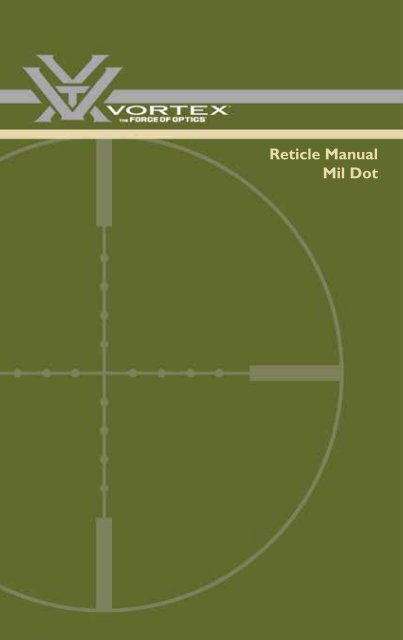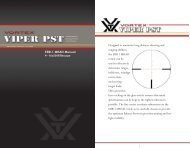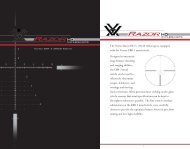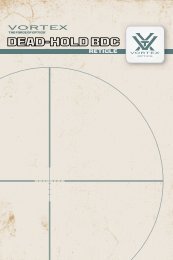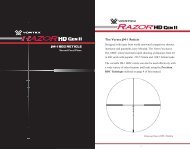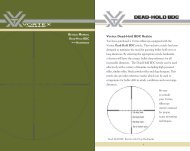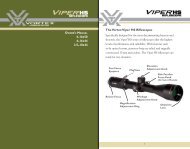Reticle Manual Mil Dot - Vortex Optics
Reticle Manual Mil Dot - Vortex Optics
Reticle Manual Mil Dot - Vortex Optics
You also want an ePaper? Increase the reach of your titles
YUMPU automatically turns print PDFs into web optimized ePapers that Google loves.
<strong>Reticle</strong> <strong>Manual</strong><br />
<strong>Mil</strong> <strong>Dot</strong>
<strong>Vortex</strong> <strong>Mil</strong> <strong>Dot</strong> <strong>Reticle</strong><br />
The <strong>Vortex</strong> <strong>Mil</strong> <strong>Dot</strong> reticle is an extremely versatile reticle allowing<br />
the user to do range estimations, holdover and wind drift<br />
compensation, as well as moving target leads.<br />
<strong>Vortex</strong> <strong>Mil</strong> <strong>Dot</strong> <strong>Reticle</strong><br />
When used with second focal plane riflescopes it is very important<br />
to understand that in order to use the listed subtensions<br />
correctly, the scope must be set to a particular magnification<br />
(usually the highest). Consult the riflescope owner’s manual for<br />
the correct magnification to be used. Of course, the standard<br />
center crosshair can always be used at any magnification.<br />
The mil dot reticle subtensions are based on the milliradian<br />
(mrad for short). Mrad unit of arc measurements are based on<br />
the radian. A radian is the angle subtended at the center of a<br />
circle by an arc that is equal in length to the radius of the circle.<br />
These angles and arc scales are used to estimate range and bullet<br />
trajectory drop with<br />
the mil dot reticle.<br />
There are 6.283<br />
1 <strong>Mil</strong> Width at Distances<br />
100 yards ------------------------ 3.6 inches<br />
200 yards ------------------------ 7.2 inches<br />
radians in a circle and 300 yards ----------------------- 10.8 inches<br />
400 yards ----------------------- 14.4 inches<br />
1000 milliradians in<br />
500 yards ----------------------- 18.0 inches<br />
a radian for a total 600 yards ----------------------- 21.6 inches<br />
of 6283 milliradians<br />
(mrads) in a circle.<br />
An mrad will subtend<br />
700 yards<br />
800 yards<br />
----------------------- 25.2 inches<br />
----------------------- 28.8 inches<br />
3.6 inches at a distance of 100 yards. Most riflescopes with mrad<br />
adjustments use .1 mrad clicks which subtend .36 inches at 100<br />
yards.<br />
<strong>Vortex</strong> <strong>Mil</strong> <strong>Dot</strong> reticle<br />
subtensions shown in milliradians<br />
(mrad or mils).<br />
1
Ranging<br />
To use a mil dot reticle for ranging purposes, you must have an<br />
object of known dimension at the same distance as your target<br />
to which you can compare the mil spacing. Then you can use the<br />
simple formula below to calculate distance. This easy formula can<br />
be used for all ranging situations:<br />
Known Dimension (in yards) x 1000<br />
<strong>Mil</strong>s Read<br />
Examples of Objects of Known Dimensions<br />
• A fence post known to be 36 inches tall that is next to the coyote<br />
you’re shooting at.<br />
• The brisket-to-back distance of 18 inches on a whitetail buck.<br />
• The height of 10 inches for a standing ground hog.<br />
• A target that is 20 inches in diameter.<br />
Using the first example, place the<br />
reticle on the fence post with the<br />
horizontal crosshair even with<br />
the ground—remember that<br />
the scope must be turned to the<br />
correct magnification. Reading<br />
the mils, the fence post equals 2<br />
mils in height.<br />
= Yards to Target<br />
Windage Compensation<br />
Using the mil dot reticle for windage and moving target<br />
leads will require thorough knowledge of your cartridges<br />
ballistic performance and experience in properly reading<br />
wind strengths. Again, the scope must be at the correct<br />
magnification for this to work.<br />
Remembering that 1 mil equals 3.6 inches at 100 yards, 7.2<br />
inches at 200 yards, 10.8 inches at 300 yards, etc., use the<br />
mil dots on the horizontal crosshair to hold-off the required<br />
distance. Remember to hold into the wind direction when<br />
doing this.<br />
Example of Wind Drift Compensation<br />
Lets say you’re shooting at a target 400 yards away with a small<br />
crosswind. Through experience, or after consulting ballistics<br />
information, you believe the<br />
bullet will wind-drift about<br />
7 inches. At 400 yards, each<br />
mil spans 14.4 inches (see<br />
chart on page 2), so you’ll need<br />
to hold about ½ mil into the<br />
wind to correctly compensate<br />
and make your shot.<br />
Using the formula shown above, you can calculate the distance to the<br />
fence post (and the coyote) at 500 yards.<br />
1 Yard (36 inches) x 1000<br />
= 500 Yards<br />
2<br />
2<br />
3
Holdover<br />
Once a target has been ranged, the mil dot reticle can be used<br />
to quickly estimate proper hold-over on longer shots. In order<br />
to do this, you will have to be very familiar with the ballistics<br />
of your particular weapon and ammunition at all distances. It<br />
can be very helpful to keep a printed ballistic chart handy. As<br />
always, your scope must be set to the correct magnification.<br />
Example of <strong>Reticle</strong> Holdover<br />
Let’s say you’ve ranged a deer with your mil dot and<br />
determined that he is 300 yards away. You’ve zeroed in your<br />
rifle at 100 yards, and know<br />
through practice and ballistics<br />
info that your bullet will drop<br />
11 inches at 300 yards. You<br />
know that the mil spacing<br />
on the reticle is equal to 3.6<br />
inches at 100 yards. This<br />
means the mil spacing will<br />
be 10.8 inches at 300 yards.<br />
Therefore, to make your shot you’ll need to hold the center<br />
crosshair about 1 mil high from the deer’s vital zone.<br />
For additional information on using the mil dot reticle,<br />
be sure to consult the <strong>Vortex</strong> Long Range Ballistic<br />
Compensation (LRBC) program. You’ll find this at<br />
www.vortexoptics.com.<br />
The LRBC program will allow users to input their specific<br />
ballistic information and, then, see a graphic representation<br />
of the mil dot reticle displaying specific yardages and wind<br />
drifts for each dot.<br />
If you have any questions, contact <strong>Vortex</strong> <strong>Optics</strong>. Call us at<br />
800-426-0048 or e-mail service@vortexoptics.com.<br />
<strong>Vortex</strong> <strong>Optics</strong><br />
2120 West Greenview Drive<br />
Middleton, Wisconsin 53562<br />
USA<br />
24<br />
35
MIL-DOT-11A<br />
© <strong>Vortex</strong> <strong>Optics</strong> USA


